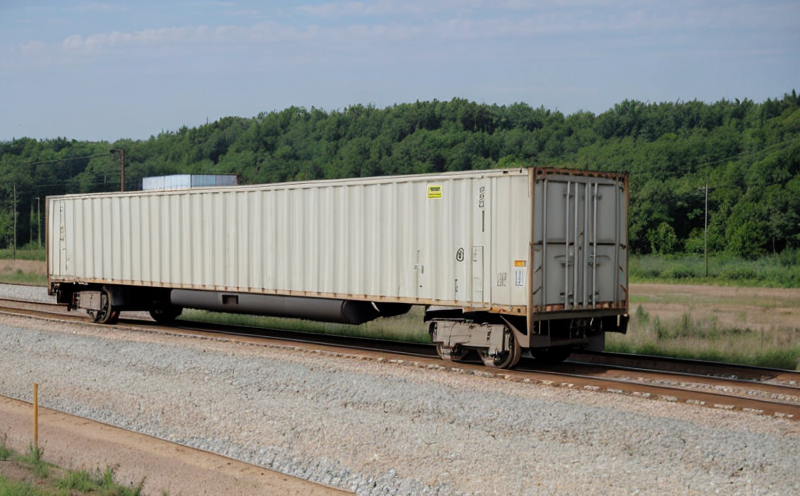EN 12663 End Wall Compression Testing of Wagon Structures
The EN 12663 standard is an integral part of railway and transportation testing that ensures the structural integrity and safety of cargo and freight wagons. This test evaluates the compressive strength of end walls in wagon structures, which are critical components that ensure the stability and safety of the load during transit.
The primary purpose of this testing is to verify whether the materials used meet the specified requirements for structural strength under compression. Compliance with EN 12663 ensures that railway wagons can withstand the stresses encountered during operation without compromising on safety or operational efficiency. This standard applies not only to freight wagons but also to any other rail vehicles where end wall structures are present.
The testing process involves subjecting a specimen, typically an end wall panel cut from actual wagon structures, to gradually increasing compressive loads until it reaches its maximum load capacity or until visible signs of failure appear. The test setup includes a hydraulic press capable of applying controlled forces and displacement rates that mimic real-world conditions.
Preparation of the specimen is crucial for accurate testing results. Specimens must be representative of actual wagon structures, which means they should reflect the same materials, thicknesses, and manufacturing processes used in production. Any discrepancies could lead to inaccurate test outcomes and potentially flawed conclusions about the structural integrity of wagons.
Once prepared, the specimen is placed into a compression testing machine that applies force uniformly across its surface until failure occurs. The equipment records various parameters during testing, including load measurements, displacement rates, and stress-strain relationships. These data points are essential for assessing compliance with EN 12663 requirements.
The acceptance criteria outlined in EN 12663 specify that the end wall must maintain its structural integrity up to a certain compressive load value without undergoing unacceptable deformation or failure. If the specimen fails before reaching this threshold, it indicates potential weaknesses in material selection or design that need addressing before production can proceed.
Compliance with EN 12663 is mandatory for manufacturers of new wagons as well as those involved in modifications or repairs to existing vehicles. It ensures consistent quality across all units produced by different suppliers and contributes significantly to overall railway safety standards.
| Parameter | Description |
|---|---|
| Load Capacity | The maximum compressive load that the end wall can sustain before failure occurs. |
| Displacement Rate | The rate at which displacement is applied during testing to simulate real-world conditions. |
| Stress-Strain Relationship | The relationship between the internal stresses within the material and corresponding strains experienced during loading. |
| Material Properties | Description |
|---|---|
| Steel Grade | The type of steel used in constructing the end wall, affecting its strength and durability. |
| Thermal Treatment | The process applied to enhance certain properties such as hardness or toughness. |
| Manufacturing Process | The techniques employed during production that influence final product quality. |
Industry Applications
The EN 12663 end wall compression testing is widely used across various sectors within the railway and transportation industry. One of its primary applications involves ensuring compliance with international standards for new wagon manufacturing processes, particularly those involved in high-speed rail services.
In addition to new vehicle construction, this test also plays a crucial role in validating repairs and modifications made to existing wagons. For instance, after an accident or prolonged use leading to wear and tear, end walls may require reinforcement or replacement. Testing ensures that these changes do not compromise the overall structural integrity of the wagon.
Another key application lies in quality assurance programs aimed at maintaining consistent standards throughout manufacturing plants. By regularly testing samples according to EN 12663, companies can identify variations in material properties or workmanship early on and take corrective action if necessary.
| Sector | Application |
|---|---|
| Railway Transportation | Ensuring compliance with international safety standards for new vehicle manufacturing. |
| Freight Industry | Validating repairs and modifications to existing wagons after accidents or prolonged use. |
| Quality Assurance Programs | Maintaining consistent standards throughout manufacturing plants through regular testing. |
Quality and Reliability Assurance
The importance of quality assurance in railway and transportation cannot be overstated. By adhering to EN 12663, manufacturers can significantly enhance the reliability and safety of cargo and freight wagons used in various applications.
One critical aspect of this is ensuring that all components meet specified strength requirements under compressive loads. This reduces the risk of structural failures during transit, which could lead to accidents or derailments. Additionally, regular testing helps catch any issues early on, allowing for timely interventions before they escalate into larger problems.
Achieving compliance with EN 12663 also contributes positively towards brand reputation by demonstrating a commitment to high standards of quality and safety. This is particularly important in an industry where public trust plays a significant role in maintaining customer confidence.
Use Cases and Application Examples
- New wagon manufacturing processes involving high-speed rail services.
- Repairs and modifications made to existing wagons after accidents or prolonged use.
- Maintaining consistent quality throughout different manufacturing plants through regular testing.
In each of these scenarios, the EN 12663 test serves as a critical tool for ensuring that wagon structures meet stringent safety standards before being put into service. This not only protects passengers and cargo but also contributes to overall railway reliability and efficiency.
| Use Case | Description |
|---|---|
| New Wagon Manufacturing | Ensuring that newly manufactured wagons comply with international safety standards. |
| Repair and Modification | Validating repairs or modifications made to existing wagons after accidents or prolonged use. |
| Quality Assurance Programs | Maintaining consistent quality throughout different manufacturing plants through regular testing. |





